Pursuing Arts in the spaces between
An appreciation of the arts beyond the pandemic serves as the inspiration for the upcoming NUS Arts Festival.
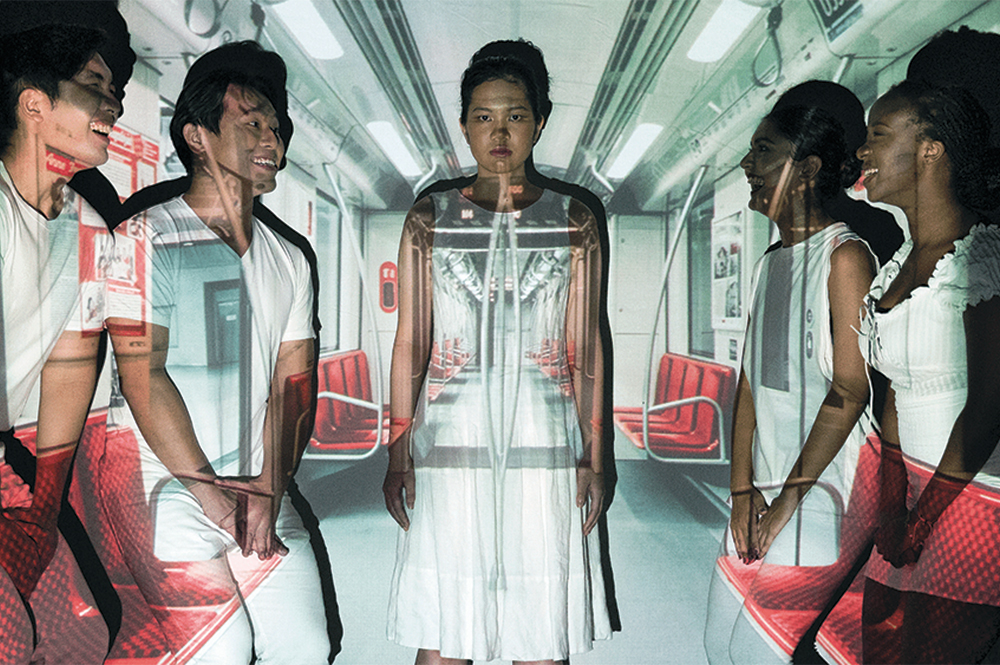
The value of the arts in society was a hotly contested topic during the early days of the COVID-19 restrictions.
A public poll by The Straits Times in 2020 had ranked “artist” as being the most “non-essential” worker, sparking outrage and feelings of injustice within the arts community. The irony is glaring, considering that a National Arts Council study published a year later showed that digital arts consumption shot up by between 78 and 88 per cent during the COVID-19 pandemic.
Despite the seeming disconnect between reality and public perception, what is clear is that the arts are essential to daily living, even in the midst of a pandemic. More than a pleasant distraction from the trials of life, the arts serve as a valuable channel through which today’s university students can develop interdisciplinarity, negotiate the unknown and create new possibilities.
One key platform through which NUS supports the development of the arts is the NUS Arts Festival, which has been a campus arts staple since 1998. The platform seeks to use the arts as a launchpad to discuss contemporary issues that deserve deeper attention or discussion. The festival, which runs from 10 to 26 March 2023, is themed Spaces Between, and touches on ideas of transition, change, pause and ambiguity. This discussion of Space is the final chapter in a trilogy of festival themes that covered universal concepts of Time (in A Question of Time in 2020, and Light (in Shades of Lightness in 2021). “The purpose of the festival theme is to allow us to reflect on the times we live in through art – and so Spaces Between seems especially apt given how we are still adjusting to what a new normal means,” shared Ms Jobina Tan, from NUS Centre For the Arts (CFA), who is in her second year as Festival Director. “Furthermore, art has always been a vehicle in which we discover ourselves and find a confluence between different states.” A veteran in the arts scene, Ms Tan has over 20 years of combined experience in arts education and programming.
A Bumper Crop of Inter-disciplinary Collaborations
NUS CFA has been hard at work, collaborating with more than 700 student and alumni artists, industry collaborators and faculty members to prepare over 20 live productions, films, installations and dialogues. A signature feature of the festival is its interdisciplinary collaborations, many of which are the first-of-its-kind in NUS or Singapore. These partnerships encourage artists to leave their comfort zones and navigate the spaces between, to present a blended balance of separate art forms and presentation styles. “There is a bumper crop of four collaborations between the student arts groups this year – a mammoth undertaking, given that all productions are original works, and so the preparations become even more complex,” shared Ms Tan.” Some of these pairings are particularly uncommon, such as NUS Chinese Dance with NUS Indian Instrumental Ensemble, NUS Chinese Drama with NUS Chinese Orchestra, and NUS Ilsa Tari (our Malay Dance group) with NUS Dikir Barat.”
An Avenue for Engaging our Alumni
Held since 1998, the
NUS Arts Festival features three weekends of arts programming, making it NUS’s largest arts event. Over the span of 25 years, the festival has been a constant platform to nurture, grow and evolve generations of student artists, some of whom have gone on to become influential artists and educators in Singapore and beyond. Despite their busy schedules, many of these alumni return to give back to NUS by being involved in shaping the arts experience of current students, and the
NUS Arts Festival is one of these avenues.
NUS CFA consciously seeks to connect with alumni, leveraging their experience both onstage as artists, and offstage as role models, “The alumni we have invited are respected artists and leaders in their own fields. The intention is that they become inspiring examples for students to see that they could aspire to be like these creative individuals — pursuing passions, taking risks and overcoming obstacles along the way,” Ms Tan added. The
AlumNUS meets some of our alumni artists to learn more about the festival programmes they are involved in.
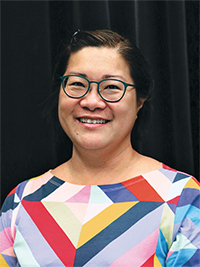
Ms Judy Ngo (Arts and Social sciences ’96)
Ms Judy Ngo is the Artistic Director of 1N THE ACT, which focuses on education through drama. She started teaching in 2000 and often works with schools as a CCA instructor, drama instructor and Artist-In-School. She has over 25 years of experience in acting, teaching and directing theatre, and has worked with many theatre companies in Singapore including The Theatre Practice, W!ld Rice, The Necessary Stage and Drama Box. She directs
Essentially Macbeth, a Chinese theatre production about a group of ex-drama club members returning to the theatre to present
Macbeth while searching for their own identity. It is the first collaboration of its kind between NUS Chinese Drama and NUS Chinese Orchestra (NUSCO).
What inspired you to pick Macbeth as source material for this production?
At its heart,
Essentially Macbeth poses the perennial question “are the Arts Essential?”. I used Macbeth and his dream to be king as a basis of comparison to my lead character’s wild ambition of making the arts essential in Singapore.
Essentially Macbeth touches on the changes in goals and aspirations that we experience between life stages. Is this a reflection of the reality you see within your drama students who have left the arts upon graduation?
Ideally, I hope that the arts will remain a part of their lives so that they do not have to go through what some of the characters went through. But there is also a much larger picture at play here, I hope that
Essentially Macbeth will remind every single one of us that the arts play a crucial part of our daily lives.

Mr Paul Tan (Arts and Social sciences ’95)
An Honours graduate in English Literature, Mr Tan has published five collections of poetry and various short stories in anthologies and journals. Besides being a published author, he was formerly Deputy Chief Executive of the National Arts Council and Director of the Singapore Writer’s Festival. He is currently a PhD candidate at Nanyang Technological University. For
NUS Arts Festival 2023, he is the curator of
Not Only Lines, a multi-site installation of poetry by 30 NUS alumni, all of whom are prominent literary figures in Singapore. In keeping with the festival’s focus on liminality, the works will be displayed at transitory spaces within NUS Kent Ridge and Bukit Timah Campuses.
The project title Not Only Lines is inspired by the late Dr Arthur Yap (Arts and Social Sciences ’63)’s first poetry collection, only lines. How does Not Only Lines pay homage to him?
It wasn’t difficult to land on Arthur Yap’s poem only lines as an organising framework for this public art project. The poem seems like a modest, seemingly whimsical piece of writing. But it touches on the power of language and the different ways of seeing the world. Like many of his poems, Yap’s meanings are always open-ended, and often slippery; behind the lines, you get the hint of a knowing poetic sensibility with a wry sense of irony.
How do you hope the project will be received by audiences on campus?
The NUS Arts Festival allows us to celebrate the many poets that NUS has nurtured through the years, and to represent the diversity of their voices and bring their talents to an audience on campus. Of course, poetry in a public space is encountered differently from when reading verse in the quiet of one’s mental solitude. We hope these poems on public display put a smile on those who encounter them but at the same time, whet the appetite to read and know more about the poets who have contributed significantly to Singapore’s literary landscape.
You were active in the NUS arts scene as a student. How does it feel to return to NUS as an alumni and contribute to the arts scene once again?
As an alumnus and English Literature graduate, I am glad to have the opportunity to contribute to this meaningful project. Apart from Yap’s work, most of the other poems will be new works so the team and I are confident that NUS students, faculty members and visitors will have fresh, thoughtful, site-specific encounters with these poems throughout campus.
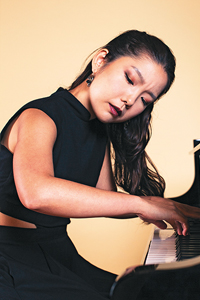
CHUREN (Music ’15)
Singaporean contemporary classical pianist CHUREN has performed as a soloist and with orchestras in Singapore, Hong Kong, Cambridge, London, Paris, Milan, Dresden, Vienna and Hamburg, amongst others. The 2021 season included debuts at the
Singapore International Piano Festival,
Singapore International Festival of Arts and the
Candlelight Concerts by Fever series. In July 2022, she opened the Singapore Symphony Orchestra’s 2022/23 season with Grieg’s
Piano Concerto conducted by Han-Na Chang. CHUREN attained her two Masters Degrees in Music and Philosophy from Yale University and Cambridge University, as well as her Bachelors from the Yong Siew Toh Conservatory of Music, where she is currently an Artist Fellow.
How did the concept for MOONRISE come about?
The moon is a source of beauty and inspiration for me. There’s something magical about sitting beneath a full moon and observing the infinite colours as it shifts between wisps of clouds. This sounds a bit airy-fairy, but somehow magical things or moments of clarity and creativity tend to come to me when I spend time under the moon. I do that alone a lot and also some of my favourite moments with the people I love have been spent that way. Clearly some classical composers thought so too — like Debussy with Clair de Lune or Beethoven with the Moonlight Sonata.
How is Spaces Between explored?
This marks the first time I am fully producing a multi-genre and multi-disciplinary show. We explore the liminal space between three different artistic praxes: classical piano, music production and video art. We want to transcend the boundaries of our individual disciplines and build synergy between the realms of sound and vision. The ‘Spaces Between’ are where we feel there is the most potential for innovation.
Why did you choose a less-conventional space like the University Cultural Centre (UCC) Atrium as the venue for MOONRISE?
I chose the UCC Atrium to create a sense of unexpectedness of walking into an artistic world for audience members. The Atrium is quite a unique space; with its arced main wall, and the way the lowered ceiling at the transition from the foyer relents to the relative cavernous height of the main area. This spacious, somewhat cave-like quality (especially when the space is darkened) is perfect for pulling an onlooker into a different world from the outside. Rightly so, as one of the ‘Spaces Between’.
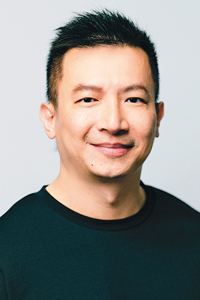
MR CHONG TZE CHIEN (Arts and Social sciences ’99)
Mr Chong, a graduate from the NUS Theatre Studies programme, is the Artistic Director for NUS Stage, a core member of The Finger Players and an award-winning playwright and director. Some of the awards he has won include the Singapore Dramatist Award and
The Straits Times Life! Theatre Awards. His plays have been staged in Singapore, UK, Hungary, Taiwan and Japan. He has produced two collections of plays, that include critically-acclaimed works such as
Charged and
PIE.
For his contributions to Singapore theatre, he received the Young Artist Award 2006 by Singapore’s National Arts Council. Mr Chong is involved in two productions within
NUS Arts Festival – End of the Line, a fantastical jukebox musical performed by theatre group NUS Stage, and
The Future Show, a one-woman play featuring NUS alumna, Ms Jo Tan (Law ’04), which tells the ‘true story’ of the rest of one performer’s life, starting from the end of the performance and ending on the day they die.
How do you juggle your commitments to both?
I’m probably mad trying to juggle both but it’s all in a day’s work! The two pieces are vastly different from each other, with different goals and approaches. For that reason, I am driven by the different challenges presented by each production.
How different is End of the Line compared to past NUS Stage works?
We are incorporating pop music and lip syncing in a piece that takes on the style of a jukebox musical. With that in mind, the members have been undergoing lip syncing and movement exercises as well as dancing sessions on top of their regular actors’ training. The learning curve is steep but the members are learning and applying these new skills in our devising sessions with gusto.
The Future Show is based on a concept and score by Deborah Pearson. What drew you and Jo Tan to the source material, and how has it been adapted for Singapore/NUS audiences?
I was drawn to the imagination and vision of a singular idea explored to its fullest potential. The writing of the original is robust and visceral, which also provides room for additional input by whoever adapts it. I’m terribly excited by the possibilities we are generating from marrying our input with Deborah’s narrative score, which serves as a template for our adaptation. Conceptually, the script will be reframed to suit a Singapore context. The additional input and revisions will be informed by Jo’s personal anecdotes and experiences from the time when she was a student in NUS, and more.
The performance will also take place in a secret location within the NUS campus! Audiences will only know the exact place upon arrival at our front-of-house. We hope to create an intimate performance which resonates experientially with its unique storytelling style and form.
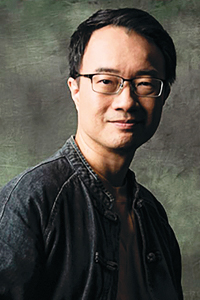
MR BENJAMIN ANG (Law ’93)
Mr Ang never left the NUS Electronic Music Lab (EML) – he enjoyed his time performing, composing and recording as a student member so much that he stayed on as alumni, eventually becoming appointed as Principal Tutor. Today, he is one of the select few Ableton Certified Trainers in Southeast Asia, and trains EML members in producing, performing and promoting original electronic music. Guided by Mr Ang, NUS EML presents
OmnIVerse: The Fourth Dimension, an immersive sonic experience in collaboration with designers Bernice Ong and bani haykal that highlights the liminality of space, music and material to take audiences to a superliminal fourth dimension.
How did the concept of OmnIVerse: The Fourth Dimension come about?
Our Omniverse series of concerts started three years ago, with the concept of exploring different universes of sound. Because while electronic music takes many forms, many people perceive electronic music on the whole as sounding out of this world. We combined these ideas into OmnIVerse: The Fourth Dimension because time is a fourth dimension that, when applied to a three-dimensional space, can make it liminal. For example, a walkway may be distinct and busy during the day, but become empty and liminal in the night.
This is a site-specific performance. What can audiences expect?
Instead of sitting in fixed seats facing a fixed stage, the audience can move around the studio, which is divided into multiple spaces, some of which are liminal, and some of which are not. In this way, they experience the feelings of being in liminal spaces which are transient and change. They will find music in the ‘spaces between’ because some of the performers are in some of these spaces, while other spaces are activated with electronic soundscapes.
For people unfamiliar with electronic music, how would you encourage them to come to experience OmnIVerse: The Fourth Dimension?
Come and discover the ‘spaces between spaces’ that we usually pass through without noticing in our everyday lives. Experience the sounds of those spaces and the music inspired by them, some which could be soundtracks that evoke the mood in between, while others could be surprising rhythms and beats from unexpected sources.
 NUS Arts Festival
NUS Arts Festival takes place from 10 to 26 March 2023. It is open to the public, and ticketed shows are sold via Bookmyshow. Visit
www.nusartsfestival.com for details.